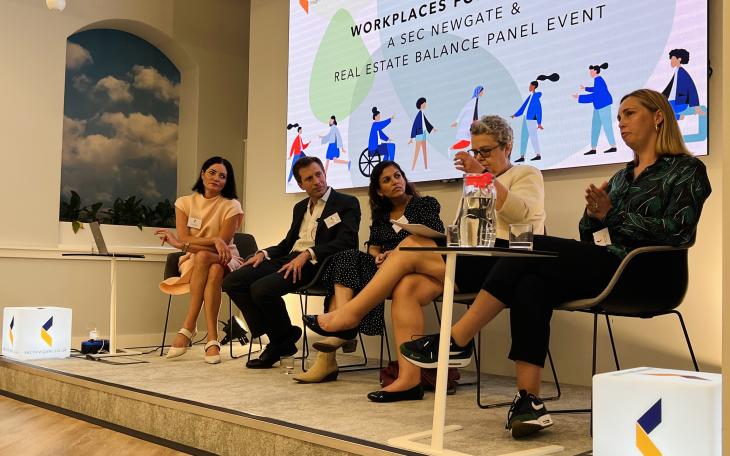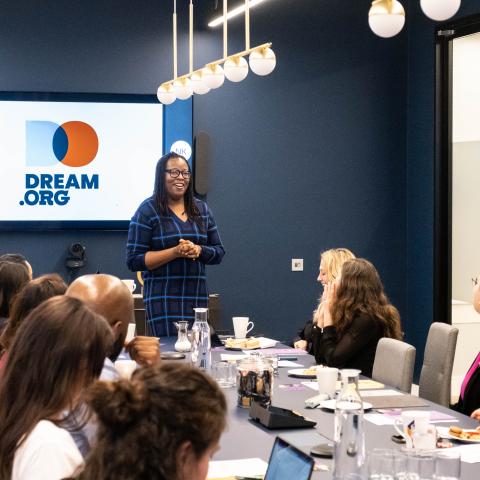How can we ensure that workplaces work for women?

Gender equality and inclusivity in the workplace is an increasingly prominent issue within the real estate sector. Today, various challenges persist, resulting in workplaces failing to fully accommodate the needs and aspirations of women. From the design of physical spaces to supporting career growth, numerous factors must be considered and addressed. At SEC Newgate’s London HQ, we recently co-hosted a panel discussion with Real Estate Balance on how to ensure that workplaces truly work for everyone, and here are some of the highlights.
One fundamental aspect of creating workplaces that work for women is to examine how offices are designed and used. Designing women-friendly workspaces should encompass a broad range of considerations. From air conditioning settings, which are often set at optimum temperatures for male employees, types of seating available (high stools can cause unnecessary stress for women wearing skirts or dresses), and lighting to the height of shelves - all are aspects of standard workplaces that often do not adequately account for the needs of women. This will inevitably impact an individual’s sense of belonging and result in them avoiding the space altogether.
Incorporating a gendered lens into the design process is critical in ensuring workplaces can be more inclusive spaces. Working with design teams and suppliers that have a broad range of lived experiences and establishing guiding principles will help mitigate any gender biases. For example, an isolated site belonging to educational institution, University College London (UCL), posed a potential feeling of uneasiness amongst female academics. This was alleviated by designing the site so it had clear lines of visibility, security guards on site and ensuring the area was well lit.
To ensure diversity within the workforce the underrepresentation of women in senior roles within the real estate industry also needs to be addressed. With only a small number of women in architectural and property development organisations holding influential positions, promoting more senior women and individuals from diverse backgrounds will ensure that decision-making processes and perspectives encompass a broader range of experiences and insights. For women who do embark on a career in the sector, measures need to be put in place to ensure they feel seen – from ensuring PPE sizes cater to women to the support they need to progress in their careers.
Consulting and engaging with those who will be using the workspace is another key aspect of designing a workplace that caters for a range of needs and priorities. When it comes to the design of the office itself, retrieving insights and having a flexible planning process enables employee feedback to be incorporated into the plans. This is something SEC Newgate has successfully fostered following the move to our new offices last year. By continuing to engage with staff on how the various spaces within the office can be improved, 14 Greville Street has been undergoing ongoing tweaks and alterations that reflect employee feedback.
Inclusive workplaces must also recognise specific needs and experiences amongst a female workforce. From addressing language used in job descriptions - for example ‘young and vibrant workforce’ can make older employees feel excluded - to avoiding organising meetings at 8am to cater for those who are mothers and need to be available for the morning school run, to allowing flexible working days for mature, experienced employees looking to slow down but not stop their careers, can all help showcase awareness that different women will have diverse needs and priorities.
The need to show awareness of these diverse needs and priorities is perfectly exemplified by The British Standards Institute’s recently published guidance on menstruation and menopause. Representing a timely and ground-breaking step to gender equality in the workplace, insights and suggestions include having temperature controls in individual rooms so that, for example, women who are experiencing hot flushes, a common symptom of the menopause, are able to take themselves into a room and adjust the temperature to suit their individual needs, without drawing attention to their condition or inconveniencing anyone else.
Ensuring that workplaces work for women requires a multifaceted approach that addresses various aspects of the physical office design, the representation of women in senior roles as well as the implementation of supportive policies. By recognising and addressing gender disparities in workplace design, operations, and culture, we can create environments that promote gender equality, support career progression, and maximise the potential of women in the workforce. It is only through collective action that we can achieve workplaces that work for everyone, irrespective of gender








